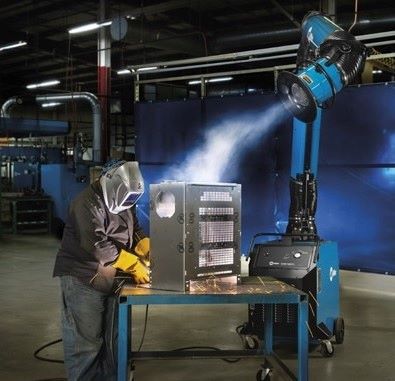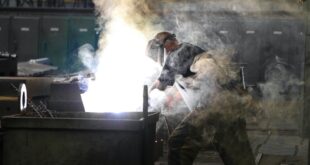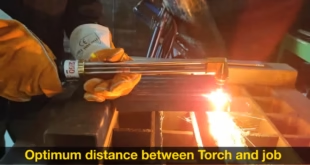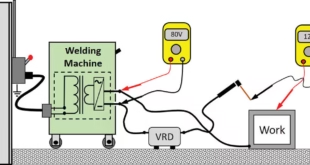Welding Fume Extraction Systems
Welding is widely used in various industries to join materials, particularly metals, together. This process, while essential, releases hazardous fumes and gases. Welding fumes contain toxic metal particles and other harmful substances that pose serious health risks to welders and those in the surrounding area.
Introduction Fume Extraction Systems
Welding fume extraction systems are critical safety solutions designed to capture, filter, and remove these harmful contaminants from the air. Without such systems, the air quality in a welding environment can deteriorate rapidly, increasing the risk of respiratory diseases and other health complications. This article will cover everything from what welding fumes are, the health risks they pose, the types of extraction systems available, and how to select and maintain them.

What Are Welding Fumes?
Definition of Welding Fumes
Welding fumes are a mix of gases and fine particulate matter that are released into the air when metals are heated to high temperatures during the welding process. These particles are typically very small and can remain suspended in the air, where they are easily inhaled by anyone in the vicinity.
Composition of Welding Fumes
The exact composition of welding fumes varies based on the materials being welded and the type of welding being done. Common materials found in welding fumes include:
- Metal oxides from the base material and filler rods.
- Silicates and fluorides used in welding consumables.
- Harmful gases such as carbon monoxide, nitrogen oxides, and ozone.
These components can be dangerous, especially when inhaled in large quantities over time. Each welding process generates different levels and types of fumes, with some processes, like MIG and Stick welding, producing higher fume concentrations than others, such as TIG welding.
Health Risks Associated with Welding Fumes
Long-Term Health Impacts
One of the most significant concerns with exposure to welding fumes is the long-term damage it can cause to the respiratory system. Prolonged exposure can lead to serious, sometimes irreversible, conditions. The most common long-term health risks include:
- Lung cancer: Welders exposed to certain metals like hexavalent chromium and nickel are at a higher risk of developing lung cancer.
- Chronic bronchitis: Continuous exposure to welding fumes can inflame the lungs’ airways, leading to chronic coughing and breathing difficulties.
- Pulmonary fibrosis: This condition involves the scarring of lung tissue, making it hard to breathe properly.
Immediate Health Concerns
In addition to long-term risks, short-term health effects from exposure to welding fumes include:
- Irritation of the eyes, nose, and throat: This is one of the first signs of overexposure to fumes.
- Metal fume fever: A flu-like illness caused by inhaling zinc fumes from welding galvanized steel.
- Dizziness and nausea: Inhaling gases like carbon monoxide can reduce the amount of oxygen in the blood, leading to symptoms like dizziness, fatigue, and nausea.
Given these significant health risks, controlling exposure to welding fumes is vital for protecting workers’ well-being.
Why Fume Extraction Systems Are Essential
Protecting Worker Health
One of the main reasons for using fume extraction systems is to protect the health of welders and other workers in the area. These systems reduce the concentration of harmful particles and gases in the air, which helps prevent respiratory diseases and other health problems.
Meeting Safety Regulations
Workplaces that involve welding must comply with strict occupational safety regulations. Agencies like OSHA (Occupational Safety and Health Administration) in the U.S., as well as similar organizations in other countries, have set guidelines for acceptable levels of airborne contaminants. Welding fume extraction systems help businesses meet these regulatory requirements, avoiding fines and ensuring a safe working environment.
Types of Welding Fume Extraction Systems
Source-Capture Systems
Source-capture systems are designed to extract fumes right at the welding point, preventing them from spreading into the larger workspace. One common example of a source-capture system is the Extraction Arm. This device consists of a flexible arm with a hood that hovers directly above the welding site. The hood collects the fumes as soon as they are generated, and they are then filtered and released back as clean air. Extraction arms are highly adjustable, allowing welders to move them as needed to optimize fume capture. They are widely used in smaller welding stations or workbenches where space is limited.
Extraction ArmsExtraction arms offer high efficiency and versatility in confined spaces. They come in both self-supporting and mechanized versions, allowing welders to adjust the arm’s position to capture fumes right at the welding source. Because they prevent fumes from dispersing, extraction arms are highly effective in reducing the exposure to harmful particles and gases.
Ambient-Capture Systems
Ambient-capture systems focus on purifying the air in the entire workshop rather than capturing fumes at the source. These systems are ideal for large spaces where multiple welders may be working simultaneously, and direct source-capture isn’t feasible.
Overhead Filtration Units
In large workshops where welding takes place in different locations, Overhead Filtration Units are commonly used. These systems are installed on the ceiling and use large fans to circulate air, pulling in contaminated air from various points in the room and filtering it through HEPA or other high-efficiency filters. They are not as precise as source-capture systems but are beneficial for maintaining overall air quality across large spaces.
Portable Extraction Systems
Portable extraction systems provide mobility and are ideal for workshops where welders need to move between stations. They are designed for ease of use and can be transported to different locations within the workspace.
On-Torch Extraction Systems
As explained earlier, on-torch extraction systems are designed to remove fumes directly at the welding torch. This provides an effective fume removal solution that follows the welder, minimizing the need for stationary or bulky equipment. Welders can work freely while ensuring their immediate breathing zone remains clear of harmful fumes.
Stationary Extraction Systems
Stationary extraction systems are permanent fixtures designed for larger-scale operations. They are ideal for workshops where a significant volume of welding fumes is generated, and the welding areas remain consistent.
Centralized Extraction Systems
A Centralized Extraction System connects multiple welding stations to a single, large extraction unit. Ductwork is installed throughout the workspace to collect fumes from various welding points, and these fumes are transported to a central filtration unit that removes hazardous particles. Centralized systems are ideal for factories and large-scale welding operations where multiple welders work simultaneously in fixed locations. These systems are powerful and can handle high volumes of fumes, ensuring a clean and safe working environment throughout the entire facility.
How Welding Fume Extraction Systems Work
Filtration Process
At the core of any welding fume extraction system is the filtration process. Once the fumes are captured, they pass through a series of filters that trap harmful particles. High-Efficiency Particulate Air (HEPA) filters are commonly used because they can capture particles as small as 0.3 microns. Some systems also include activated carbon filters to remove gases and odors.
Airflow Control
Proper airflow is critical to the effectiveness of a fume extraction system. Too little airflow, and the system won’t capture enough fumes. Too much airflow, and it might disturb the welding process. Modern systems often come with adjustable airflow settings, allowing them to be fine-tuned based on the specific welding process or environmental conditions.
Choosing a right Fume Extraction System
Several factors should be considered when selecting a welding fume extraction system:
Type of Welding Process
Different welding processes produce different levels of fumes. For example, MIG welding tends to produce more fumes than TIG welding. The fume extraction system should be chosen based on the type of welding being done.
Size of Work Area
The size of the workshop plays a critical role in determining which system to use. Larger spaces may require multiple extraction points or a more powerful system to maintain clean air.
Number of Welders
If there are multiple welders working in the same space, a more robust extraction system is necessary to handle the increased volume of fumes.
Air Quality Standards and Regulations
Ensure that the system you choose complies with local air quality regulations. Failure to meet these standards can lead to penalties, so it’s important to choose a system that meets all legal requirements.
Benefits of Using Fume Extraction Systems
The use of welding fume extraction systems offers several benefits:
Improved Worker Health and Safety
The most obvious benefit is improved worker health. By reducing the amount of harmful fumes in the air, these systems help prevent long-term health problems, such as respiratory diseases and cancer.
Better Air Quality and Productivity
Cleaner air also leads to improved productivity. Workers are more focused, alert, and less likely to take time off due to illness when they are working in a safe, healthy environment.
Maintenance for Fume Extraction Systems
To ensure the continued efficiency of fume extraction systems, regular maintenance is essential.
Regular Maintenance Routines
Filters should be checked and replaced regularly, as clogged filters can reduce the system’s airflow and efficiency. Maintenance schedules will vary depending on the size of the system and how frequently it is used.
Maximizing Efficiency and Lifespan
To get the most out of a fume extraction system, follow best practices for system operation. This includes adjusting airflow settings for different welding tasks and performing regular system checks to ensure everything is functioning correctly.
FAQs
Do all welding processes produce harmful fumes?
Yes, most welding processes release some level of fumes, though the amount and type of fumes depend on the specific process and materials used.
How do I know if my fume extraction system is working efficiently?
Regular system checks and monitoring the condition of filters are good ways to ensure the system is working properly. An air quality monitor can also help track fume levels.
Are portable fume extraction systems less effective than stationary ones?
Portable systems are effective for small-scale operations but may not handle the same volume of fumes as stationary systems, which are better suited for large workspaces.
What kind of maintenance is required for fume extraction systems?
Regular filter replacement, airflow checks, and general system inspection are all part of maintaining an extraction system.
Can welding fume extraction systems remove harmful gases?
Yes, systems with activated carbon filters can help remove harmful gases like ozone and carbon monoxide, in addition to particulate matter.
Conclusion
Welding fume extraction systems are essential for any workplace that involves welding. These systems help protect workers from harmful fumes, comply with safety regulations, and improve the overall work environment. With different types of systems available, it’s important to choose the one that best suits your needs, based on the type of welding, the size of the workspace, and the number of welders. Regular maintenance and proper operation of these systems ensure that they continue to function efficiently, keeping the air clean and workers safe.
 Welding of Welders All about Welding and Welders
Welding of Welders All about Welding and Welders



